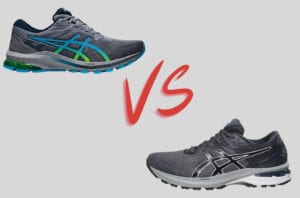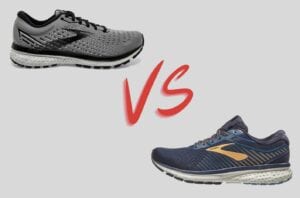If you’re reading this guide, it’s probably safe to assume that you’re a runner! And as a runner, you need to know what kind of features you can expect from popular running shoes. Today, we’re discussing Brooks vs Asics. These brands are currently sitting at the top of the running shoe food chain, and for good reason.
As you will soon discover, both Brooks and Asics offer a wide range of high-quality running shoes, with features that make them stand out from much of the competition. We will share the main differences between these two brands and notable features that make them so popular among runners.
In doing so, we will make it easier for you to determine which brand is the better fit for your needs.
Brooks and Asics, at-a-Glance
Upon examining both brands, it’s clear that neither skimps on research and development. Brooks running shoes feature technological advancements that help improve comfort and performance.
These advancements become even more evident when you wear Brooks shoes. Instead of relying on traditional components, Brooks employs a proprietary Guide Rail system that results in a comfortable fit and stellar support.
Asics, on the other hand, utilizes a modern medial post system to provide runners with a great fit and exceptional stability.
Shoes by Category
Depending on your needs as a runner, both Brooks and Asics classify their shoes under four categories to help you find the right type of shoes.
Brooks’ shoe categories are as follows:
- Energize
- Connect
- Cushion
- Speed
Asics’s shoe categories include:
- Compete
- Cushion
- Stability
- Trail
Whereas Asics has its own category for stability running shoes, Brooks offers a custom stability line within each of its four categories. As such, you can get Brooks Energize Stability running shoes, Speed Stability running shoes, and so on.
Every shoe is made up of four layers. You have the outsole, midsole, insole, and upper. Both Brooks and Asics running shoes have unique midsoles that help differentiate the two brands. Similarly, Ortholite sock liners can be found within each brand, as well. It is this feature that helps give Brooks and Asics running shoes their snug fit and feel.
Let’s take a closer look at the features that make these two heavyweights industry leaders today.
Build Quality and Fit
Outsoles
Brooks and Asics running shoes sport outsoles are made from durable rubber compounds. The difference, however, is that each brand utilizes these compounds in different ways.
Brooks typically designs its outsoles to be made entirely of rubber, whereas Asics utilizes a Trusstic system that separates rubber among the forefoot and rearfoot of the outsole. By doing this, Asics running shoes can more effectively prevent accidental twisting, thus offering runners better stability while in motion.
A large part of what makes Asics running shoes so stable is the use of AHAR and AHARPLUS. “AHAR” is short for “Asics High-Abrasion Resistance.” As its name implies, this durable rubber compound provides enhanced resistance to abrasions while you run, giving you both better cushioning and traction.
Brooks takes somewhat of a different approach to stabilizing its shoes. Having removed itself from traditional medial posts, Brooks now designs its running shoes with the proprietary Dual-Arch Pod system.
The result is improved stability and greater flexibility along the forefoot. The innovations don’t end there. Brooks also offers a protective feature in its Trail series that prevents protrusions from harming your feet.
Thanks to a ballistic-level shield between the outsole and midsole, you don’t have to worry about stepping on sharp objects as you walk or run. What’s more, Brooks’ Trail line of shoes is equipped with a TrailTrack system that enables you to have enhanced grip for inclines on the trail.
Midsoles
The most significant difference between Brooks’ and Asics’s midsoles is the material used. Brooks uses polyurethane, while Asics uses gel.
The pragmatic variation between these two materials is quite compelling. Brooks’ polyurethane approach means their midsoles are built for comfort and longevity. Nearly every model of Brooks running shoes features a wealth of cushioning.
The midsole technology employed by Brooks comes in variations that cater to the specific needs of runners. As such, you can typically find a shoe designed around the most popular running needs. Moreover, Brooks’ Energize line of running shoes delivers enhanced response while you run. The DNA Amp, for example, ensures more energy return, giving runners better dexterity.
Asics is known for its gel midsoles. Wearers can find the use of gel in both the heel and forefoot of the midsole, resulting in smoother transitions and less heel strike. Like the DNA Amp found in Brooks’ shoes, Asics’s FlyteFoam offers excellent energy return in a lightweight body. Light as it may be, FlyteFoam still provides long-lasting performance.
Which shoe you ultimately decide on depends on your preferences as a runner.
If you’re looking for a great fit, Asics will likely satisfy your needs. The heel counter in Asics serves to keep your heel locked comfortably in place while providing plenty of support.
Brooks is a better option if you’re more concerned with stability. Its Guide Rail system is designed to prevent overpronation as you run, thus ensuring a stable running experience.
It’s important to note that Guide Rail will not fix overpronation. But it will reduce its impact on your running. As a result, you can look forward to running more naturally, and by extension, more safely.
When it comes to these two brands’ midsoles, Asics is ideal for comfort, while Brooks is better suited for those looking for stability.
Uppers
Each brand designs its uppers in a way that delivers different results and benefits. Asics focuses on giving runners a snug, comfy fit.
Thanks to Asics’s FluidFit mesh uppers, you can look forward to a tight but cozy-fitting running shoe. Your foot stays securely in place as you move, further adding to its benefits.
Brooks, however, is known for its shoes coming with a bigger toe box. Be that as it may, most wearers recommend that you buy Brooks running shoes a half-size larger to get a comfortable fit.
You’re still getting a supportive mesh upper with Brooks running shoes—there’s just a size variation you need to be aware of. Brooks’ 3D Fit mesh system offers excellent breathability and support.
Durability
Now that you know what to expect from each brand’s build quality and construction, let’s talk about performance and reliability.
For the most part, Brooks seems to offer better durability in its running shoes. The reason for this is quite simple. Asics continues to develop lightweight running shoes, always trying to improve and deliver a lighter shoe.There’s certainly nothing wrong with this, but it does come at a price. Developing a lighter-weight shoe means giving up on material and components that offer durable qualities.
In terms of mileage, both brands offer respectable performance. Brooks running shoes are designed to withstand anywhere between 300 and 500 miles. Asics, however, states that its running shoes are built to last between 450 and 550 miles. Although Asics says its shoes will last longer, real-world reports seem to point to Brooks as the longer-lasting running shoe.
Still, hundreds of miles of durability and performance are remarkable for any running shoe, and both brands deliver exceptional results.
Cushioning
Brooks offers stellar cushioning in its running shoes. When you slip your foot in a Brooks shoe, you can expect extra support and plush comfort.
Both Asics’s FlyteFoam and Brooks’ DNA Amp technologies deliver quality cushioning throughout their running shoes. If you like a lot of cushioning as you run, Brooks won’t disappoint. The plush feel around your feet stays with you, even in movement.
Asics’s tried-and-true gel goes a long way in giving runners a memorable running experience. The use of gel in Asics running shoes has been around for decades. And there’s a reason that it’s lasted this long. It works well in providing a comfortable shoe for runners around the world. There’s no need to change something that continues to be loved by fans to this day.
Asics has undoubtedly improved on its cushioning technology. In doing so, comfort continues to be one of the brand’s strong points.
Wrap Up
As you can see, there’s a lot to like about both brands. After reviewing each brand’s advantages, it’s easy to see why Brooks and Asics are the top two brands in the world right now.
If you want quality and dependability, you could probably flip a coin and be happy with either brand of running shoe. Price-wise, both brands again come relatively close to one another.
You can expect to spend between $100 and $200 for both Brooks and Asics running shoes. Upon research, it appears that Asics offers more models slightly below the $100 mark than Brooks offers.
Regardless of how much you spend, you can trust that you’ll be investing in a high-quality running shoe from either brand.






















